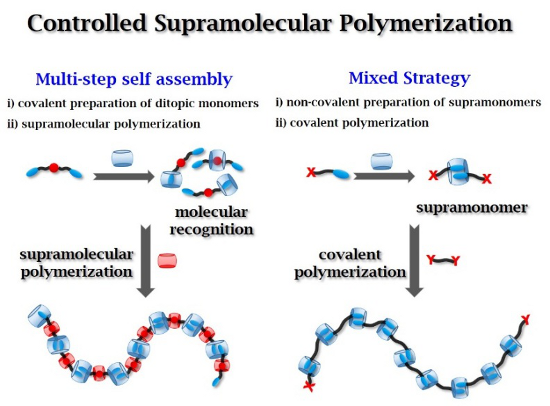 |
|
Supramolecular polymers are of great interest because the nature of non-covalent interactions holding them together imparts dynamic, reversible and degradable characteristics to these materials. We have been developing new strategies to fabricate supramolecular polymers, leading to advancement of controlled supramolecular polymerization. One is multi-step self-assembly, which includes covalent preparation of ditopic monomers and supramolecular polymerization of the ditopic monomers. In recent year, we have reported a series of supramolecular polymers based on host (Cucurbit[8]uril) enhanced interactions, such as host-enhanced charge transfer interactions and host-enhanced π-π interactions. Several strategies are employed to promote the supramolecular polymerization, such as the select of systems with high binding constants, the design of ABBA-type of monomers. Based on these strategies, supramolecular polymers with high degree of polymerization are achieved in dilute aqueous solution, while the dimerization and cyclization are successfully prohibited.
In addition, we have developed controlled supramolecular polymerization by self-sorting recognition process. Another method involves so-called mixed strategy, including non-covalent preparation of supramonomers and covalent polymerization of the supramonomers. It is highly anticipated that these studies enrich the fabrication methods of supramolecular polymers, but also facilitate the molecular weight and structure control of supramolecular polymers.
More recently, we have proposed the new method of supramolecular interfacial polymerization by combining supramolecular chemistry with interfacial polymerization. This strategy further will enriches the methodology of supramolecular polymerization and open a new route for the controllable fabrication of supramolecular polymeric materials. |
|
 |
| Recent Publications: |
| Angew. Chem. Int. Ed. 2010, 49, 6576; Chem. Eur. J. 2011, 17, 9930; Chem. Eur. J. 2012, 18, 15650; Chem. Soc. Rev. 2012, 41, 5922; Polym. Chem. 2013, 4, 5378; Langmuir 2013, 29, 12909; Chem. Commun. 2013, 49, 5766; Chem. Asian J. 2013, 8, 1626; Polym. Chem. 2013, 4, 900; Polym. Chem. 2014, 5, 53; Polym. Chem. 2014, 5, 323; Polym. Chem. 2014, 5, 1471; Angew. Chem. Int. Ed. 2014, 53, 5351; Polym. Chem. 2014, 5, 5895; Chem. Commun. 2014, 50, 11173; Polym. Chem. 2014, 5, 6439; Polym. Chem. 2015, 6, 369; Polym. Chem. 2015, 6, 681; Chem. Rev. 2015, 115, 7196; ACS Macro Lett. 2015, 4, 611; ACS Macro Lett. 2015, 4, 1410; Polym. Chem. 2016, 7, 1397; Polym. Chem. 2016, 7, 2333; ACS Macro Lett. 2016, 5, 1084; ACS Macro Lett. 2016, 5, 1397; Acta Polym. Sinica 2017, (1): 3; Acta Polym. Sinica 2017, (1): 37; J. Polym. Sci. Part A: Polym. Chem. 2017, 55, 604; ACS Appl. Mater. Interfaces 2017, 9, 11368; Angew. Chem. Int. Ed. 2017, 56, 7639; Macromol. Rapid Commun. 2017, 38, 1700312; Angew. Chem. Int. Ed. 2017, 56, 16575. |
|
| |
 |
|
|
|